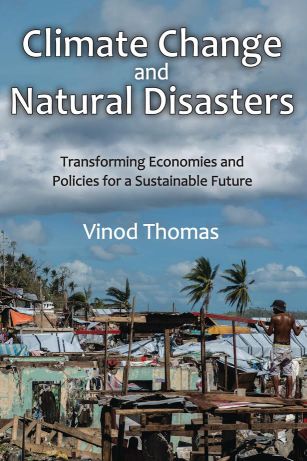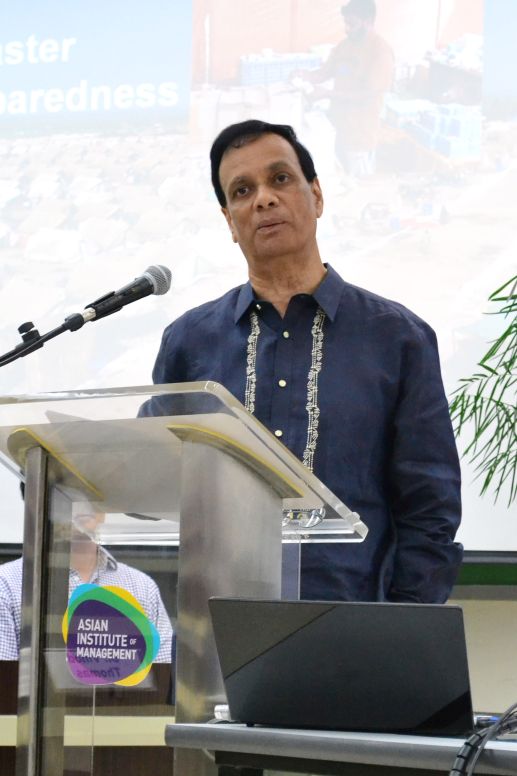MAKATI CITY – The Stephen Zuellig Graduate School of Development Management of the Asian Institute of Management will soon be launching new short courses and a Master in Disaster Risk and Crisis Management (MDRCM) degree program. These form a vital part of the Institute’s advocacy to society and its response to the complex issues that challenge sustainable business and human development.
In light of the Institute’s plans, and in collaboration with the Asian Development Bank, AIM launched the book, Climate Change and Natural Disasters: Transforming Economies and Policies for a Sustainable Future by Dr. Vinod Thomas.
“With the launch of a new book, Natural Disasters and Climate Change on April 6, 2017, the Asian Institute of Management directs attention to the urgent need to build resilience against the growing danger of natural calamities, aggravated by climate change, in Southeast Asia and beyond,” said Dr. Thomas. “Growth ambitions of countries, be it 6% in the Philippines or India, are increasingly predicated on actions taken not only to respond and rebuild but also prepare and prevent disasters. For regions such as Southeast Asia, just as we prepare for financial crises, there need to be stress tests on the capabilities to handle multiple hazards and to shore up supply chains and livelihoods.”

In his book, the author chronicles the growing list of natural disasters in recent years. In 2009, Manila was ravaged by Typhoon Ketsana, while Typhoon Haiyan devastated the central Philippines in 2013. Floods in 2010 submerged a fifth of Pakistan’s land area, and in 2011, floods halted industrial production in Thailand. Massive rains paralyzed Jakarta in 2014, while a heatwave killed 2,400 people in India in 2015. In 2010, Russia suffered its longest heatwave for 1,000 years, killing 15,000 people, while a year-long drought in the US Midwest in 2012 caused losses of US$30 billion. The disasters do not stop there.
Dr. Thomas observes that the upsurge in extreme weather-related events underlines a worrying connect between natural disasters and climate change, driven by significant shifts in average weather conditions. According to him, a consensus is building that climate change has roots in human actions. “People have known for a long time that weather events turn into disasters for man-made reasons. More people are hurt when they are exposed in harm’s way, and when they are vulnerable and unable to cope. But now we also know that the intensity and frequency of the hazards themselves are greater because of man-made global warming,” said Dr. Thomas. “This understanding profoundly affects how countries engage in disaster risk reduction. Economic growth projections are contingent on addressing climate change. Yet few of the forecasts take into account the impacts of climate change that are already evident, or the massive investment and resources that will need to be mobilized for climate action.”
Because of this, he stresses the importance of being prepared for the new climate danger, and the necessity for action on climate change. Climate-related natural disasters are no longer one-off occurrences, but rather systemic events that require preventive action. Disaster risk reduction is an investment that goes beyond relief and reconstruction to a dual approach of prevention and recovery. Dr. Thomas highlights the need to view investments in climate change mitigation as investments in economic growth.
By considering all types of capital, including natural capital, climate action will drive economic growth, not hinder it. To deliver sustained growth and wellbeing, society needs to value natural capital, recognize the human hand in climate change, and take preventive action against climate-related calamities.

Dr. Vinod Thomas, expert resource person, thought leader, and author of the newly published book, Climate Change and Natural Disasters: Transforming Economies and Policies for a Sustainable Future, is a Visiting Professor at the Asian Institute of Management.
Book Summary
The start of the new millennium will be remembered for deadly climate-related disasters — the great floods in Thailand in 2011, Super Storm Sandy in the United States in 2012, and Typhoon Haiyan in the Philippines in 2013, to name a few. In 2014, 17.5 million people were displaced by climate-related disasters, ten times more than the 1.7 million displaced by geophysical hazards.
In this setting, this book sends three messages.
First: human-made factors exert a growing influence on the frequency and intensity of climate-related disasters.
Second: because of the link to human-made factors, there is a pressing need for climate mitigation as an integral part of the development strategies of countries.
Third: prevention, including climate adaptation, should not be viewed as a cost to economic growth but as a necessary and high-return investment.
In Southeast Asia and everywhere, attention to climate-related disasters can be instrumental in transitioning to a path of low-carbon growth, improving disaster resilience, and caring for the urban environment.
Endorsements for the Book
“Climate Change and Natural Disasters is not only a valuable survey of the causes and consequences of climate change, but also a ringing endorsement of the urgent need to incorporate disaster risk reduction in core economic planning alongside efforts to radically reduce greenhouse gas emissions.” —Robert Glasser, special representative of the Secretary-General for Disaster Risk Reduction, The United Nations Office for Disaster Risk Reduction
“A highly authoritative, lucid and timely analysis of the implications of climate change and disasters for sustainable development—the universally accepted path for humanity in the 21st century.” —Mohan Munasinghe, chairman, Munasinghe Institute for Development
“A thought-provoking examination of the links between climate change and natural disasters, and how to tackle both. Its call for greater investments in natural capital, “nature’s infrastructure”—in addition to physical and human capital—to meet these critical 21st century challenges is particularly timely and welcome.” —Inger Andersen, director general, International Union for Conservation of Nature
“This excellent analysis confirms that in an increasingly fragile world we need greater focus on investment in disaster risk reduction, climate mitigation and adaptation. This is the only way to move towards the new paradigm we have universally endorsed with the Sustainable Development Goals.” —Kristalina Georgieva, European Commission vice-president and former EU commissioner for International Cooperation, Humanitarian Aid and Crisis Response xxiii Climate Change and Natural Disasters xxiv
“Recent extreme climate impacts in Asia and across the world underscore the urgent need to act on climate change. Policymakers need every resource available to put in place effective policies and incentives to achieve the vision outlined in the 2015 Paris Agreement, and this book holds great potential to secure the practical pathways that can turn the Paris vision into reality.” —Christiana Figueres, executive secretary, United Nations Framework Convention on Climate Change
“Estimates suggest that South and South-East Asia, as well as Sub-Saharan Africa, would be most severely affected by climate change, particularly by the increase in natural disasters. This new report provides an extensive survey of the issues of climate risk mitigation, adaptation, resilient infrastructure and calls for the transformation of policy framework. I highly welcome this input to address these longterm but imminent challenges.” —Rintaro Tamaki, deputy secretary-general, Organisation for Economic Co-operation and Development (OECD)
“This landmark study demonstrates that natural disasters are increasingly man-made. Cutting across knowledge domains it offers a comprehensive, positive and realistic policy agenda that captures the universal aspirations of the post 2015 sustainable development era.” —Robert Picciotto, former director general, Independent Evaluation Group, World Bank
“This is a timely and engagingly written book on an important topic of increasing international concern.” —Jagdish Bhagwati, Columbia University
“By focusing on the connection between hazards of nature and climate change, this book provides compelling reasons for countries to switch urgently to a low-carbon growth path. This would enable the world not only to avoid the most damaging of the climate scenarios but would also deliver cities where we can move, breathe and be productive, investments to promote sustainable agriculture and rural economies, and foster ecosystems that can move from fragile to flourishing. A timely and essential read.” —Nicholas Stern, IG Patel Professor of Economics and Government, LSE and President, British Academy
“A compelling evidence-based call to action on the climate-natural disaster link. A must-read for development economists and advocates in rich and poor countries alike.” —Nancy Birdsall, president, Center for Global Development
“The book provides rich data behind the realities Oxfam is grappling with every day — an escalation of disasters linked to climate change which are hitting the poorest hardest everywhere. Its call to radically scale-up investment in adaptation and building resilience must be heard if we are to tackle this climate injustice.” —Winnie Byanyima, executive director, Oxfam International










